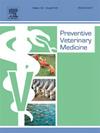Comparing efficiencies of population control methods for responding to introductions of transboundary animal diseases in wild pigs
IF 2.2
2区 农林科学
Q1 VETERINARY SCIENCES
引用次数: 0
Abstract
Introductions of transboundary animal diseases (TADs) into free-ranging wildlife can be difficult to control and devastating for domestic livestock trade. Combating a new TAD introduction in wildlife with an emergency response requires quickly limiting spread of the disease by intensely removing wild animals within a contiguous area. In the case of African swine fever virus (ASFv) in wild pigs (Sus scrofa), which has been spreading in many regions of the world, there is little information on the time- and cost-efficiency of methods for intensively and consistently culling wild pigs and recovering carcasses in an emergency response scenario. We compared the efficiencies of aerial operations, trapping, experimental toxic baiting, and ground shooting in northcentral Texas, USA during two months in 2023. Culling and recovering carcasses of wild pigs averaged a rate of 0.15 wild pigs/person hour and cost an average of $233.04/wild pig ($USD 2023) across all four methods. Aerial operations required the greatest initial investment but subsequently was the most time- and cost-efficient, costing an average of $7266 to reduce the population by a standard measure of 10 %, including recovering carcasses. Aerial operations required a ground crew of ∼7 people/helicopter to recover carcasses. Costs for reducing the population of wild pigs using trapping were similar, although took 13.5 times longer to accomplish. In cases where carcass recovery and disposal are needed (e.g., response to ASFv), a benefit of trapping was immediate carcass recovery. Toxic baiting was less efficient because both culling and carcass recovery required substantial time. We culled very few wild pigs with ground shooting in this landscape. Our results provide insight on the efficiencies of each removal method. Strategically combining removal methods may increase overall efficiency. Overall, our findings inform the preparation of resources, personnel needs, and deployment readiness for TAD responses involving wild pigs.
比较应对野猪跨界动物疫病传入的种群控制方法的效率
跨界动物疾病(TAD)传入自由放养的野生动物可能难以控制,并对国内牲畜贸易造成破坏。要以紧急应对措施遏制新的 TAD 传入野生动物,就必须在毗连地区内集中清除野生动物,从而迅速限制疾病的传播。野猪(Sus scrofa)中的非洲猪瘟病毒(ASFv)已在世界许多地区传播,但在应急响应情况下,有关集中、持续扑杀野猪并回收尸体的方法的时间和成本效益的信息却很少。在 2023 年的两个月里,我们在美国得克萨斯州中北部比较了空中作业、诱捕、试验性毒饵投放和地面射击的效率。在所有四种方法中,捕杀和回收野猪尸体的平均比率为 0.15 头野猪/人小时,平均成本为 233.04 美元/野猪(2023 年美元)。空中作业所需的初始投资最大,但随后的时间和成本效益最高,平均花费 7266 美元即可将野猪数量减少 10%,包括回收野猪尸体。空中作业需要 7 人/直升机的地面工作人员来回收尸体。使用诱捕法减少野猪数量的成本与此类似,但需要花费 13.5 倍的时间才能完成。在需要回收和处理尸体的情况下(如应对 ASFv),诱捕的好处是可以立即回收尸体。毒饵诱捕的效率较低,因为扑杀和尸体回收都需要大量时间。在这片土地上,我们通过地面射击捕杀的野猪数量很少。我们的研究结果让我们了解了每种清除方法的效率。有策略地将清除方法结合起来可能会提高整体效率。总之,我们的研究结果为涉及野猪的战术性退化评估应对措施的资源准备、人员需求和部署准备提供了参考。
本文章由计算机程序翻译,如有差异,请以英文原文为准。
求助全文
约1分钟内获得全文
求助全文
来源期刊

Preventive veterinary medicine
农林科学-兽医学
CiteScore
5.60
自引率
7.70%
发文量
184
审稿时长
3 months
期刊介绍:
Preventive Veterinary Medicine is one of the leading international resources for scientific reports on animal health programs and preventive veterinary medicine. The journal follows the guidelines for standardizing and strengthening the reporting of biomedical research which are available from the CONSORT, MOOSE, PRISMA, REFLECT, STARD, and STROBE statements. The journal focuses on:
Epidemiology of health events relevant to domestic and wild animals;
Economic impacts of epidemic and endemic animal and zoonotic diseases;
Latest methods and approaches in veterinary epidemiology;
Disease and infection control or eradication measures;
The "One Health" concept and the relationships between veterinary medicine, human health, animal-production systems, and the environment;
Development of new techniques in surveillance systems and diagnosis;
Evaluation and control of diseases in animal populations.
 求助内容:
求助内容: 应助结果提醒方式:
应助结果提醒方式:


